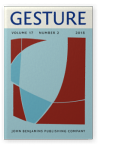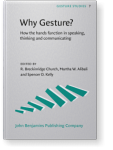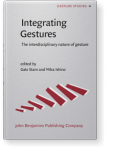David McNeill
List of John Benjamins publications for which David McNeill plays a role.
Journal
2018 Recurrent gestures: How the mental reflects the social Gesture 17:2, pp. 229–244 | Article
Using recurrent gestures as the model, this essay considers how an inside-looking-out view of speech-gesture production reflects the interactive-social exterior. The inside view may appear to ignore the social context of speaking and gesture, but this is far from the truth. What an exterior view… read more
2017 Chapter 5 Supplement. Exchange on gesture-speech unity: What it is, where it came from Why Gesture?: How the hands function in speaking, thinking and communicating, Church, Ruth Breckinridge, Martha W. Alibali and Spencer D. Kelly (eds.), pp. 103–125 | Chapter
Abstract
The following is the edited version of an exchange that took place in 2013 between Renia Lopez-Ozieblo and David McNeill on McNeill’s paper Gesture – Speech Unity – What it is, where it comes from(in this volume) and his 2012 book How Language Began: Gesture and Speech in… read more
2017 Chapter 5. Gesture-speech unity: What it is, where it came from Why Gesture?: How the hands function in speaking, thinking and communicating, Church, Ruth Breckinridge, Martha W. Alibali and Spencer D. Kelly (eds.), pp. 77–101 | Chapter
Abstract
Minimal packages of language embodiment have been called growth points (GPs). In a GP gesture and speech are inherent and equal parts. Out of a GP comes speech orchestrated around a gesture. Can theories of language origin explain this dynamic process? A popular theory,… read more
2014 The emblem as metaphor From Gesture in Conversation to Visible Action as Utterance: Essays in honor of Adam Kendon, Seyfeddinipur, Mandana and Marianne Gullberg (eds.), pp. 75–94 | Article
Emblems contain inner metaphors – precision for “OK,” the so-called conduit metaphor for the grappolo, for example. Other metaphors are Up is Good, Bad is Down in “thumbs up/down,” and Beams and Obstacles in “warding-off” (including the “horn”). Cultures historically pick metaphors, codify them… read more
2014 Gesture–speech unity: Phylogenesis, ontogenesis, and microgenesis Language, Interaction and Acquisition 5:2, pp. 137–184 | Article
This paper outlines an argument for how development in child speech and gesture could shed light on language evolution: child acquisition can be thought of as two types of acquisition, one of which goes extinct (gesture-first, Acquisition 1) and is replaced by another (gesture–speech unity,… read more
2011 Chapter 3. Birth of a Morph Integrating Gestures: The interdisciplinary nature of gesture, Stam, Gale and Mika Ishino (eds.), pp. 27–48 | Chapter
When speech is prevented, gesture morphs emerge de novo. The morphs include standards of good form and syntagmatic values. However, when speech is present, gestures do not attain morph status, do not have standards of form or syntagmatic values. read more
2010 Growth points from the very beginning The Emergence of Protolanguage: Holophrasis vs compositionality, Arbib, Michael A. and Derek Bickerton (eds.), pp. 117–132 | Article
Early humans formed language units consisting of global and discrete dimensions of semiosis in dynamic opposition, or ‘growth points.’ At some point, gestures gained the power to orchestrate actions, manual and vocal, with significances other than those of the actions themselves, giving rise to… read more
2008 Unexpected metaphors Metaphor and Gesture, Cienki, Alan and Cornelia Müller (eds.), pp. 155–170 | Article
Metaphoric gestures are ‘expected’ in the sense that the metaphoric image is predictable from cultural standards, such as those found in many verbal examples (cf. the ‘cup of meaning’ image in both “the film had no content” and a gesture formed with a palm upright open hand). But many metaphoric… read more
2008 Growth points from the very beginning Holophrasis vs Compositionality in the Emergence of Protolanguage, Arbib, Michael A. and Derek Bickerton (eds.), pp. 117–132 | Article
Early humans formed language units consisting of global and discrete dimensions of semiosis in dynamic opposition, or ‘growth points.’ At some point, gestures gained the power to orchestrate actions, manual and vocal, with significances other than those of the actions themselves, giving rise to… read more
2003 Aspects of aspect Gesture 3:1, pp. 1–17 | Article
Performing an action and concurrently describing it creates possibilities for observing how speech and action are synchronized and mutually shape each other. The results to be described show that iconicity is an organizing principle of motion control — actions are performed in relation to speech… read more
2001 Catchments, prosody and discourse Gesture 1:1, pp. 9–33 | Article
We present our work on the temporal integration of hierarchies of communicative actions: kinesic, prosodic and discursive. We use the device of the ‘catchment’ as the locus around which this integration proceeds. We present a detailed case study of a gesture and speech elicitation experiment in… read more
1999 Speech-gesture mismatches: Evidence for one underlying representation of linguistic and nonlinguistic information Pragmatics & Cognition 7:1, pp. 1–34 | Article
Adults and children spontaneously produce gestures while they speak, and such gestures appear to support and expand on the information communicated by the verbal channel. Little research, however, has been carried out to examine the role played by gesture in the listener's representation of… read more











